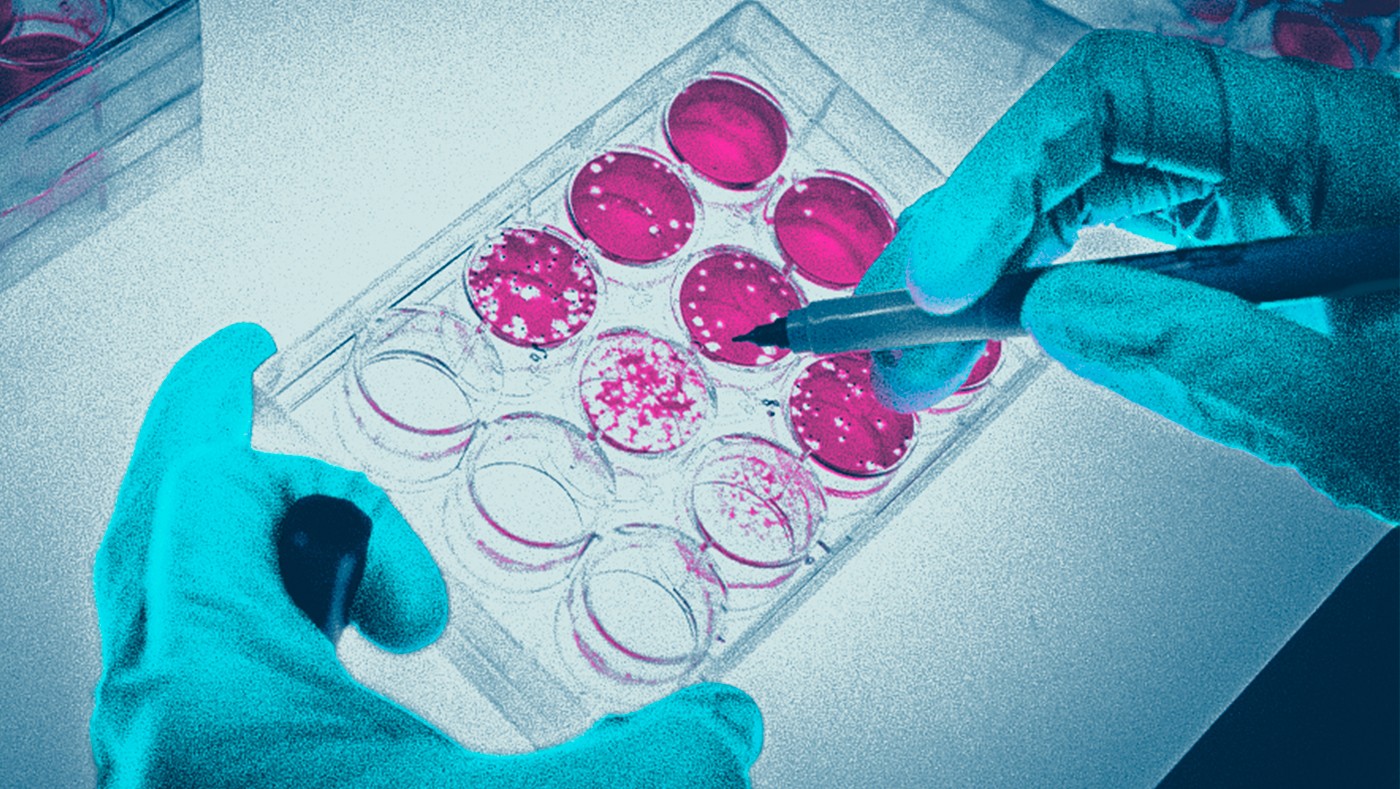Gladstone NOW: The Campaign Join Us on the Journey✕

How worried should you be about MPXV? Gladstone scientists address the basics—and dispel misconceptions—about this viral disease.
While the world continues to deal with the COVID-19 pandemic, MPXV has emerged as another global public health emergency. Commonly referred to as monkeypox, this viral disease has now spread to dozens of countries where it is not typically found.
As of August 29, 2022, over 18,000 cases have been reported in the US—the biggest outbreak of MPXV ever seen in the country. More than 700 cases have now occurred in San Francisco. Still, the general risk of MPXV remains very low.
So, how worried should you be?
We spoke with four Gladstone scientists about MPXV: Patricia Defechereux, PhD, community engagement coordinator for the HOPE Collaboratory; Nevan Krogan, PhD, senior investigator at Gladstone and director of the Quantitative Biosciences Institute at UCSF; Melanie Ott, MD, PhD, director of the Gladstone Institute of Virology; and Nadia Roan, PhD, senior investigator at Gladstone. Here’s what they said.
Why Is MPXV Usually Called “Monkeypox”?
MPXV was first discovered in 1958 in monkeys that were being used for research, and the name stuck.
“This is despite the fact that it’s thought to be found primarily in rodents, not monkeys,” Roan says.
The term “monkeypox” could reinforce offensive stereotypes about Africa and perpetuate racism.
Some have called for the World Health Organization (WHO) and other organizations to stop referring to the disease as “monkeypox.” This would avoid suggesting that monkeys are the main source of the disease.
In addition, critics note, the term “monkeypox” could reinforce offensive stereotypes about Africa and perpetuate racism—and increase shame and stigmatization that could prevent people from seeking care.
For those reasons, Gladstone has chosen to use the preferred term of MPXV, even as WHO and others continue to use “monkeypox.”
How Serious Is MPXV?
Typically, MPXV is mild. However, some people are at higher risk of severe or even fatal MPXV, such as people with weakened immune systems, children under 8, people who have had eczema, and people who are pregnant or breastfeeding.
Like COVID-19, MPXV comes in different strains. The strain behind the current outbreak is fatal in less than 1 percent of cases. Still, it causes rashes and sores that can be extremely painful and may lead to infections or permanent scarring. Other possible symptoms include fever, chills, fatigue, headaches, and muscle aches. Symptoms usually last 2 to 4 weeks.
Who Is at Risk for Getting MPXV?
People of any gender identity or sexual orientation can get MPXV if they are in close contact with someone who has it. That includes healthcare workers and caregivers for people with MPXV.
“There is still the misconception that this is a disease that will only affect the LGBTQ+ community.”
So far, over 99 percent of cases in the country have been concentrated among individuals assigned male sex at birth. The risk is higher for those who have had multiple sexual partners in areas where MPXV has been reported. Communities of color are also disproportionately affected, Defechereux notes, as they face general and wide-ranging health and resource inequities in the US.
“There is still the misconception that this is a disease that will only affect the LGBTQ+ community,” Roan says. “As we learned from the HIV/AIDS crisis, a disease primarily affecting a specific community can quickly become an epidemic affecting everyone.”
“Like HIV, the MPXV outbreak started within certain populations because of active sexual networks, and also like HIV, it can affect anyone, ” agrees Defechereux. "However, unlike HIV, MPXV infection can be spread by close, non-sexual contact with a person carrying the virus, including hugging, kissing, or sharing utensils."
How Does MPXV Spread?
Currently, the most common way MPXV spreads appears to be through direct skin-to-skin contact with rash and sores. Such contact may include hugging, massaging, cuddling, kissing, and intercourse. However, MPXV is not considered to be an exclusively sexually transmitted infection.
“Activities that put people at increased risk of sexually transmitted infections will also put people at risk for MPXV, but transmission is certainly not limited to sexual activity,” Defechereux says.
Other ways MPXV may be transmitted include living with or sharing a bed with someone who is infected, caring for someone who is infected, sharing towels or clothing, or prolonged face-to-face contact. However, it does not seem to spread during brief in-person interactions, such as walking by someone with MPXV in a grocery store.
How Is MPXV Treated?
There is no treatment specifically for MPXV currently approved by the US Food and Drug Administration (FDA). Typically, a doctor treating someone with MPXV will focus on easing symptoms and managing complications.
However, evidence suggests that a medication originally developed for smallpox, tecovirimat (TPOXX), may be effective against MPXV. That’s because MPXV and smallpox viruses are closely related.
TPOXX supplies are limited and difficult to access; available doses may be prioritized for people with weakened immune systems, including people living with HIV, who at the moment account for a disproportionately large proportion of MPXV cases.
Is There a Vaccine for MPXV?
Since 2019, US adults aged 18 and over who are at high risk for MPXV have been eligible for a vaccine called Jynneos to protect against infection. Recently, the FDA authorized emergency use of Jynneos for people under 18 who are at high risk for MPXV.
“I would suggest that people assess whether they are in one of the high-risk categories,” Roan says. “And, if you are, speak to your doctor and try to get the approved vaccine.”
“Intradermal delivery is a proven method to effectively apply vaccines and induce immunity—when done correctly!”
The US currently has a limited supply of Jynneos. To stretch available doses further, the FDA has now authorized intradermal injection—injection between layers of the skin—of Jynneos for adults. Typically, Jynneos is injected subcutaneously, meaning beneath the skin, but less of the vaccine is needed for intradermal injection. That means up to five times more people can now be vaccinated per vial.
“Intradermal delivery is a proven method to effectively apply vaccines and induce immunity—when done correctly!” says Ott. “The challenge is that the technique is not trivial, and medical personnel needs to be trained to get it right without exception.”
How Can You Protect Yourself?
“There’s still a lot we need to learn about exactly how MPXV spreads,” Krogan says. “But for now, we have a pretty good idea of how people can protect themselves.”
Here are a few ways you can help prevent the spread of MPXV:
- Get the MPXV vaccine if you are at high risk for the disease.
- If you develop symptoms, ask your doctor for an MPXV test.
- Communicate with intimate partners about any potential symptoms, including new sores or rashes anywhere on the body.
- Avoid skin-to-skin contact and sharing items with people experiencing potential symptoms of MPXV.
- Wash your hands frequently and use hand sanitizer.
- When caring for someone with MPXV, wear a mask, gown, and gloves.
If You Had the Smallpox Vaccine, Are You Protected Against MPXV?
In the 1980s, studies suggested that people who had been vaccinated for smallpox were about 85 percent protected from MPXV. However, it’s unclear how long this protection lasts, and most people born in the US since 1972 have never been vaccinated for smallpox.
“It’s possible that the higher prevalence of MPXV among younger and middle-aged men may be in part due to the lack of smallpox vaccine immunity in this group relative to older individuals, but that has not been formally established,” Roan says. “Regardless, I would suspect that those who got the smallpox vaccine still have some immunity against MPXV.”
What Is the Outlook for This Outbreak?
In 1980, smallpox was declared eradicated, thanks to the smallpox vaccine. While it’s not impossible that MPXV could be eradicated in the same way, researchers feel it is unlikely.
“MPXV has already been around for decades in humans, and it also continues to circulate in wild animals, which makes eradication difficult,” Roan says. “The world is also now much more interconnected than it was in 1980, and with all the global travel giving viruses ‘wings,’ it becomes much more difficult to contain outbreaks.”
Still, vaccination could bring things under control. And, when compared to RNA-based viruses like HIV and SARS-CoV-2, the DNA-based virus that causes MPXV is slower to mutate, hence easier to control through vaccination.
“What are mutations doing to this present strain that make it seemingly more problematic than earlier strains of MPXV? If we can understand that, we can better understand how the virus is transmitted, and ultimately discover new ways to treat and even prevent it.”
However, Ott notes, the US federal government has been slow to respond to the current outbreak.
“Despite the long-known potential threat of MPXV, both TPOXX and Jynneos were in short supply when the outbreak began,” says Ott. “The question now is, how do we apply the tools we have as best we can?”
Aside from increasing the availability of TPOXX and Jynneos, more widespread clinical testing and wastewater testing are needed to better track the spread of MPXV and inform strategies to mitigate it.
“The lack of an immediate national response, and the notion that this is a problem just among a specific community, is worrisomely similar to what was observed during the early days of the HIV/AIDS epidemic,” Roan says. “It’s pivotal that we target messaging to the most vulnerable people and rapidly roll out the prevention and treatment tools that we have available.”
Are Gladstone Scientists Studying MPXV?
Gladstone virologists are uniquely poised to study the MPXV virus using many of the same computational and experimental tools they applied to advance our understanding of SARS-CoV-2.
Their research is focused on studying the underlying molecular biology of MPXV transmission from one person to another. The key may lie in the particular genetic changes that make the strain behind the current outbreak different from prior strains.
“What are mutations doing to this present strain that make it seemingly more problematic than earlier strains of MPXV?” Krogan says. “If we can understand that, we can better understand how the virus is transmitted, and ultimately discover new ways to treat and even prevent it.”
Ott notes that one promising direction for developing new treatments may lie in combining drugs that attack the MPXV virus directly with drugs that target the biological processes hijacked by the virus to multiply in human cells. Gladstone scientists have a long track record of identifying these processes and the insights they have generated could one day lead to such an approach.
“My colleagues and I are committed to doing our part as virologists to rapidly build knowledge that could help contain the outbreak,” Ott says. “It’s what we do.”
Featured Experts
Support Discovery Science
Your gift to Gladstone will allow our researchers to pursue high-quality science, focus on disease, and train the next generation of scientific thought leaders.
Science in Seconds | Researchers Pinpoint Key Gene Behind Heart Defects in Down Syndrome
Science in Seconds | Researchers Pinpoint Key Gene Behind Heart Defects in Down Syndrome
In this video, Gladstone scientists share how they used stem cells, gene editing, and AI to identify a gene driving heart defects in Down syndrome—and how reducing its levels in mice restored normal heart development, offering hope for future treatments
Gladstone Experts Cardiovascular Disease Data Science and Biotechnology Pollard Lab Srivastava Lab AI Big Data CRISPR/Gene Editing Human Genetics Stem Cells/iPSCsScience in Seconds | The Thinking Microscope: Research Powered by an AI Brain
Science in Seconds | The Thinking Microscope: Research Powered by an AI Brain
In this video, Steve Finkbeiner and Jeremy Linsley showcase Gladstone’s groundbreaking “thinking microscope”—an AI-powered system that can design, conduct, and analyze experiments autonomously to uncover new insights into diseases like Alzheimer’s, Parkinson’s, and ALS.
Gladstone Experts ALS Alzheimer’s Disease Parkinson’s Disease Neurological Disease Finkbeiner Lab AI Big DataVisualizing Stem Cell Technology: An Animated Explainer
Visualizing Stem Cell Technology: An Animated Explainer
In this animated short, Deepak Srivastava explains how scientists can reprogram ordinary skin or blood cells back in time—turning them into induced pluripotent stem cells which are capable of becoming any cell type in the body.
Gladstone Experts Stem Cells/iPSCs






